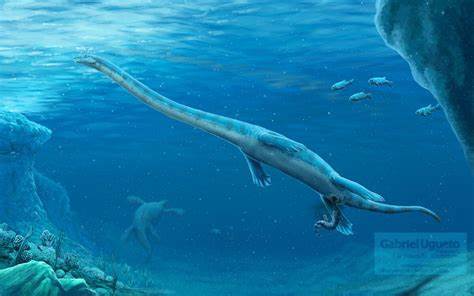A major scientific breakthrough has been made by researchers in southern China’s Guizhou Province who discovered the most complete fossil of a marine reptile, Dinocephalosaurus orientalis, that they say lived about 240 million years ago during the Triassic period. The far-stretching, very long neck and the serpent-like body of this ancient creature, in fact, reflect an eerie resemblance to the mythical Chinese dragon. This passing was the first complete look at such a fascinating species, and the fossil, which is about 16 feet long, stretches slightly over two feet. Even though Dinocephalosaurus was first spotted in 2003, the new discovery is a big deal in figuring out the full extent of its anatomy and its ecological role.
Unique Anatomy and Adaptations
The most striking attribute of Dinocephalosaurus orientalis is its truly extraordinary anatomical structure. This species differed from other long-necked marine reptiles, which simply stretched their vertebrae, by growing extra vertebrae, a total of 32 cervical vertebrae. The adaptation gave the creature a highly flexible neck that may have been what enabled it to make great stealthy catches in the water. Fossil evidence also shows preserved fish remains in the stomach, evidence that the animal had a diet rich in ocean prey and perfectly suited limbs for swimming. However, some scientists suggest that it might have used suction feeding to catch its meals, but this is still a matter for further study.
Also read: SpaceX Launches 28 Starlink Satellites from Cape Canaveral: A Giant Leap for Global Internet
A Marine Reptile That Gave Birth to Live Young
Dinocephalosaurus also has an interesting reproductive strategy. Reptiles are extremely rare in having live young, and fossil evidence suggests that was true for this one. It is apparent that this animal had fully committed itself to life in the sea: laying eggs on land would have been impossible for the animal with such specialized adaptations to water. Being able to give birth to live offspring and not have to return to land made it one remarkable step in the evolutionary process during the Triassic.
International Collaboration and Research Significance
An international group of Chinese, American, European, and British scientists discovered the complete fossil together. The result, published in the journal Earth and Environmental Science Transactions of the Royal Society of Edinburgh, has helped greatly fill in knowledge about Triassic marine reptiles. Dr. The significance of the find was emphasized by Li Chun of the Institute of Vertebrate Paleontology and Paleoanthropology, saying that Dinocephalosaurus was one of the most remarkable creatures dug up so far in Guizhou Province. The importance of global teamwork in advancing the work of paleontology is underlined by this collaboration.
Cultural Significance and Lasting Impact
It’s fabulous that Dinocephalosaurus results in a dragon-like appearance and the mixing of the lines between ancient biology and mythology. The National Museum of Scotland’s Nick Fraser said that the fossil has a very striking snake-like form that echoes the cultural imagery of the Chinese dragon. Dinocephalosaurus evolved much earlier than later marine reptiles, such as plesiosaurs, adding a precedent separate evolutionary narrative and history of mystery and wonder alone. Not only does this discovery aid in understanding what marine life looked like during the Triassic period, but it also provides proof that some ancient life forms can even provide the inspiration to craft of legends that have survived centuries.








